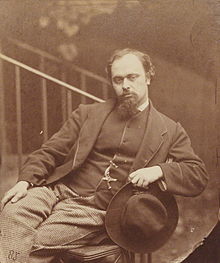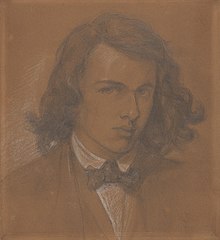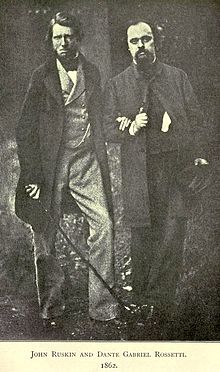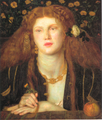Dante Gabriel Rossetti

Dante Gabriel Rossetti (born May 12, 1828 in London , † April 9, 1882 in Birchington-on-Sea , Kent ) was a British poet and painter who was equally gifted in both arts. Because of his dominant and charismatic personality, he was the driving force behind the Pre-Raphaelites who aimed to reform British art. He thought little of conventions and became an eccentric eccentric in the last years of his life.
Life
Rossetti grew up as the second of four very gifted children Maria Francesca , William Michael and Christina Georgina in an extraordinary family on Charlotte Street, near Regent's Park . His father, Gabriele Rossetti , who had fled Italy , was a poet and scientist. He was considered the capacity for Dante Alighieri's works, so it is not surprising that his son received this name. His mother, Frances Mary Lavinia Polidori, daughter of Gaetano Polidori and sister of John Polidori , was also a teacher. Because his father was a professor at King's College , Rossetti received a good education as well as drawing lessons. It was here that his preference for painting and drawing became apparent early on. So he enrolled in 1842 at Cary's Academy , which was considered a stepping stone to the Royal Academy (RA). Four years later, Rossetti became a student at the RA Antique School, a preparation that all students had to go through. As at Cary's Academy, he didn't like the RA classes, so he never became a student at the Royal Academy.
In March 1848 he asked Ford Madox Brown , whom he admired , to become his teacher. Although Rossetti was impressed by Brown's literary subjects, he was disappointed that Brown tried to teach him according to the old academic teaching methods. He then left Brown as a student, but remained a friend of his life. Up until his 20th birthday, Rossetti was undecided whether he wanted to earn a living as a poet or a painter. Without further ado, he sent a few poems to the recognized poet and critic Leigh Hunt . He praised him, but also emphasized that it was more difficult to make money with literature than with painting. Rossetti was not lacking in ideas, but he had not yet given up a job as a painter. He should get the decisive impetus through the friendship with William Holman Hunt and John Everett Millais . They lived as bohemians and all wore a knotted scarf instead of a tie.
The three could not be more different in character, but they were all dismayed by the state of British art and saw it near decay. They expressed their rejection of the prevailing conventions in painting, which they believed had been formed by imitating Raphael and his successors, by calling themselves the “ Pre-Raphaelites ”. Four other friends, including Rossetti's brother William, founded the “ Pre-Raphaelite Brotherhood ”, or PRB for short , in 1848 . These initials therefore stood on The Youth of the Virgin Mary , Rossetti's first oil painting. It received a lot of praise, it seemed the beginning of a great career. But when the press found out what was behind "PRB", he and his friends were severely attacked. Rossetti was disappointed with the harsh criticism and fell into a depression. From 1852 the PRB began to dissolve. Between 1850 and 1860 he gave up oil painting almost completely and devoted himself to small-format watercolors . Thanks to the critic John Ruskin , whom he met in 1854, these sold well, although he did not exhibit them.
As early as 1849 (or 1850) he met his future wife Elizabeth Eleanor Siddal . Lizzie conformed to the Pre-Raphaelite ideal of women; she was Rossetti's lifelong muse and source of inspiration. From 1858, another woman also played a role in his life: Fanny Cornforth . She was exactly the opposite of the delicate, ailing Lizzie. It satisfied Rossetti's sexual needs until his wedding in 1860. Shortly before, in 1858, he befriended two Oxford students. The following year, he and a few other young artists painted the boardroom of the Oxford University Union with scenes from the Arthurian legend . A year after the wedding, Lizzie gave birth to a dead child and suffered a nervous breakdown. In 1862 she committed suicide with an overdose of laudanum . Out of grief, Rossetti had his only manuscript of poems buried with her.
In the same year Rossetti leased a large house in Chelsea , 16 Cheyne Walk, on the Thames, which he shared with Algernon Charles Swinburne , a poet, and temporarily with his brother William Michael Rossetti and George Meredith . He renewed his relationship with Fanny Cornforth, who modeled for him, was his lover and took care of his household. Since his paintings were selling well, he was able to afford another model, Alexa Wilding. And another woman was his model, albeit exclusively for the face: Jane Morris , the wife of Rosetti's close friend William Morris . The longstanding affair between the two took place under the eyes of William Morris, who did not want to intervene against his friend and his wife.
For his insomnia, Rosetti had started taking chloral hydrate , the side effects of which were unknown at the time. In 1871 Rossetti swallowed a vial of laudanum - accidentally or on purpose - and hovered between life and death for a few days. Madox Brown brought him to Scotland to recover, where he stayed for a few months. From September 1872 to 1874 he lived and worked at Kelmscott Manor , which he had helped purchase.
When he left Kelmscott and was back in London, Rossetti's health was poor. In 1876/77 Rossetti moved into a house in Bognor Regis , a seaside resort in West Sussex in southern England. Rossetti took the box “Astarte Syriaca” and “The Blessed Demozel”. Dr. William Blake's Cottage in Felpham was close by. He did Rossetti's business.
In 1874 the partnership of Morris, Burne-Jones, Marshall, Webb and Faulkner with Rossetti and Madox Brown was dissolved. From then on he rarely saw Morris. Rossetti saw conspiracy in this. Alcohol and other drugs took their toll, provoking delusions, and making his hands shake that often made it impossible for him to paint. When Jane Morris discovered the extent of his chloral addiction in 1876, she broke off relations with him. Rossetti also changed a lot physically. He was steadily gaining weight, and the dark circles under his eyes gave him something sinister. Although he was a brilliant entertainer, he became more and more an eccentric . Sick, depressed, and aged prematurely, he rarely left his home. In 1881 the constantly ailing artist suffered a stroke that left arm and leg paralyzes, and Rossetti ended his longstanding relationship with Fanny Cornforth . In February of the following year he vacationed in Birchington-on-Sea. Here he died of kidney failure on Easter Sunday, April 9th, 1882.
Rossetti's grave
The burial site is in the cemetery of the Parish Church of All Saints in Birchington-on-Sea , Kent. The Irish cross was designed by Maddox Brown. The inscription reads: “Here sleeps Gabriel Dante Charles Rossetti, under the name Dante Gabriel Rossetti as a painter among painters, honored as a poet among poets. Born in London of predominantly Italian descent on May 12, 1828. Died in Birchington on April 9, 1882. "
The basis is Rosetti's monogram "R". In three reliefs are shown: St. Luke, the patron saint of painters, and again above as a winged ox. Above the ox is the poet Dante. In the middle of the cross is Eve as a symbol of seduction.
In the Church of Birchington there is a stained glass window “Preparing for Passover” based on Rosetti's design by Shields. Rossetti passed away on an Easter Sunday so this picture served as a memory.
monument
In 1877 a monument to Rossetti was erected in Chelsea on Cheyne Walk. It was a fountain designed by John Seddon with a bronze bust modeled by Madox Brown. A plaster cast is in the National Portrait Gallery . Holman Hunt gave the commemorative speech.
plant

Rossetti was one of the most unusual artists of the 19th century. He saw himself as a painting poet. He stood out from the other comrades-in-arms of the Pre-Raphaelite movement through his view and his working methods: He was neither patient nor a natural talent. He was also never interested in the exact execution of details, tended to avoid complicated backgrounds and had an aversion to landscapes . He also lacked thorough technical training. His first works (The Youth of the Virgin Mary , The Annunciation) are demanding, but also reveal the limits of his drawing and perspective . But the informative value lets forget the technical defects.
Holman Hunt believed that not only did Rossetti's work violate Pre-Raphaelite principles, but that Rossetti's work never seriously accepted the teachings. However, Rossetti's merit was that he encouraged the two brilliant artists Edward Burne-Jones and William Morris in their development.
In contrast to the other Pre-Raphaelites, he often used watercolors for his works . Rossetti developed his own style of painting here. He often applied the colors boldly and in lines and dots. In this way he achieved a jewel-like sparkle, which is particularly advantageous for heraldic decorations (see The marriage of St. George with Princess Sabra ). He made no distinction between water and oil colors . He used the techniques crosswise on many pictures. His friend William Bell Scott wrote that Rossetti had "painted with watercolor brushes in oil, with as thin a job as a watercolor". Despite his aversion to academic discipline, he was the most excellent of the Pre-Raphaelites. Often he immersed himself very much in individual topics, but he retained his versatility. So he tried his hand at wall painting in Oxford in 1857 . But his attempt failed miserably because of his imperfect technique. Working with William Morris brought his talent for stained glass to light, and he was an excellent book illustrator , although he was very little active in this field.
In the last 20 years of his work (until 1878) he concentrated almost entirely on painting pictures of beautiful, sensual women. Jane Morris, with lascivious pursed lips and flowing hair, became a symbol of the femme fatale through Rossetti's pictures . Although the images were based on mythological or literary motifs, they had no narrative moment. Because of his health and because assistants helped him with his work, his late work is inconsistent. And yet some of his paintings are among the most remarkable 19th century images of timeless importance.
Poems
- Elisabeth Luther Cary: Poems by Dante Gabriel Rossetti . GP Putman's Sons, New York 1903.
- William Michael Rossetti: The Poetical Works of Dante Gabriel Rossetti . Ellis & Elvery, London 1891.
- Hand & soul by Dante Gabriel Rossetti . William Morris and the Kelmscott Press 1895.
- Dante Gabriel Rossetti: The House of Life . A series of sonnets from the English by Otto Hauser . Eugen Diederichs, Leipzig 1900
- Dante Gabriel Rossetti: Poems and Ballads . Transferred from Alexander von Bernus and Stefan George . - Christina Rossetti : Selected poems . Transferred by Wolfgang Breitwieser. Lambert Schneider Publishing House, Heidelberg 1960
Paintings (selection)
- Found (1859, unfinished)
- The Virgin Mary's Youth (1849)
- Ecce Ancilla Domini / The Annunciation (1850)
- The marriage of St. George with the Princess Sabra (1857)
- The Song of the Seven Towers (1857)
- Beata Beatrix (1864-1870)
- Monna Vanna (1866)
- The bride (1865/1866)
- Proserpine (1874)
- Dante's dream - inspired by a poem
- The Blessed Damozel - inspired by a poem
- The shady meadow (1850–1872)
- Astarte Syriaca (1875–1877)
- Maria Theresa Zambaco (1870)
- The first anniversary of the death of Beatrice (1853)
- Russell-Cotes Art Gallery , Bournemouth , England
- Venus Verticordia
literature
- Virginia Surtees: The paintings and drawings of Dante Gabriel Rossetti (1828-1882). A catalog raisonné. 2 volumes. Clarendon Press, Oxford 1971, ISBN 0-19-817174-9 .
- Jan Marsh (Ed.): Collected writings of Dante Gabriel Rossetti. New Amsterdam Books, Chicago IL 2000, ISBN 1-56663-280-3 .
- William E. Fredeman (Ed.): The correspondence of Dante Gabriel Rossetti. 7 volumes. Brewer, Cambridge 2002-2009, ISBN 0-85991-638-3 .
- Georg Franzen: Dante Gabriel Rosetti. In: Georg Franzen: Symbolic understanding. Contributions to applied art psychology. Peter Lang, Frankfurt am Main 2004, ISBN 3-631-32111-2 , pp. 100-111.
- Dinah Roe: The Rossettis in Wonderland. A Victorian Family History . House Publishing, London 2011, ISBN 978-1-907822-01-8 .
- William Michael Rossetti: Dante Gabriel Rossetti. His Family-Letters with a Memoir (Volume One). Ellis & Elvey, London 1895.
- HC Marillier: Dante Gabriel Rossetti, An Illustrated Memorial of His Art and Life. George Bell and Sons, 3rd edition, London 1904.
- Lucinda Hawksley: Lizzie Siddal: The Tragedy of a Pre-Raphaelite Supermodel . Andre Deutsch Ltd, 2008, ISBN 978-0-2330-0258-3 .
- Kirsty Stonell Walker: Stunner: The Fall and Rise of Fanny Cornforth. CreateSpace Independent Publishing Platform , 2012, ISBN 978-1-4752-2907-3 .
- Karen Yuen: Fashioning Elite Identities: Dante Gabriel Rossetti, Edward Burne-Jones, and Musical Instruments as Symbolic Goods . In: Music in Art: International Journal for Music Iconography . 39, No. 1-2, 2014, ISSN 1522-7464 , pp. 145-158.
- Knut Wenzel : The force of the unrepresentable. Image cultures of Christianity. Freiburg i. Br. 2019, p. 109ff.
Web links
- Literature by and about Dante Gabriel Rossetti in the catalog of the German National Library
- Dante Gabriel Rossetti on kunstaspekte.de
- Works by Dante Gabriel Rossetti at Zeno.org .
- The Rossetti Archive
- Dante Gabriel Rossetti, The M's at Ems, pen drawing . British Museum
- Dante Gabriel Rossetti, Rossetti lamenting the death of his wombat (bag mouse), pen drawing . British Museum.
- Works in the Dante Gabriel Rossetti exhibition - Walker Art Gallery 2003/4
- The poetry of Drawing Pre-Raphaelites Designs, Studies and Water Colors (PDF; 5.0 MB) at Birmingham Museums and Art Gallery. January 29 - May 15, 2011
- Pre-Raphaelites: Victorian Avant-Garde - Exhibition at the Tate Gallery from September 12, 2012 - January 13, 2013
- Pre-Raphelites and their models
Individual evidence
| personal data | |
|---|---|
| SURNAME | Rossetti, Dante Gabriel |
| BRIEF DESCRIPTION | British poet and painter |
| DATE OF BIRTH | May 12, 1828 |
| PLACE OF BIRTH | London |
| DATE OF DEATH | April 9, 1882 |
| Place of death | Birchington-on-Sea , Kent |











